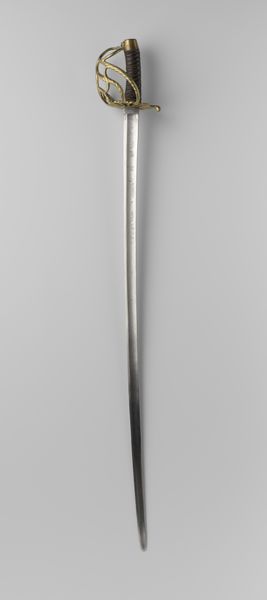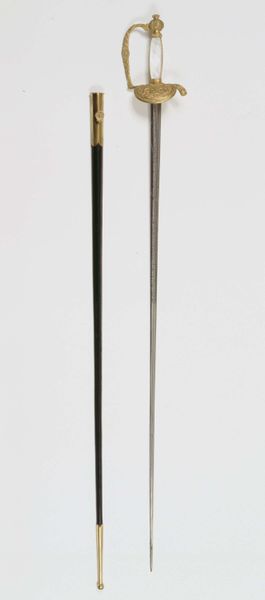
Onderstok van een paraplu of parasol van zwart geverfd hout met een gekromde haak, voorzien van twee zilverkleurige metalen ringen c. 1920 - 1940
0:00
0:00
gustavschnitzler
Rijksmuseum
mixed-media, metal, wood
#
mixed-media
#
metal
#
wood
Dimensions: length 100 cm, width 10 cm
Copyright: Rijks Museum: Open Domain
Curator: I’m struck by the utilitarian elegance of this object. It’s described as "Onderstok van een paraplu of parasol van zwart geverfd hout met een gekromde haak, voorzien van twee zilverkleurige metalen ringen," dating from about 1920 to 1940. Editor: Immediately, it evokes a sense of lost glamour. The polished wood and subtle metal details speak of a bygone era of formal dress and social rituals dictated by weather. There’s almost a sad beauty in its solitary presentation. Curator: Exactly. While seemingly humble, this umbrella handle offers insights into the processes and social meanings embedded in everyday objects. Black painted wood, with metal elements: it blends natural material with industrial finishing techniques characteristic of its time. Who crafted this, under what labor conditions? The details of its manufacture matter. Editor: Absolutely. Think about the role of the umbrella itself in shaping social interactions. The visual language of parasols signalling status, creating personal space in crowded cities. Its function dictated movements, social protocols of use and carriage. These considerations bring the object out of static display. Curator: I agree. Also consider the social role of the Rijksmuseum itself, where we stand today. What does it mean for a functional object like this—a piece of, essentially, consumer technology—to enter the museum's collection and gain recognition alongside traditionally valued art forms? It complicates hierarchies between art and artifact. Editor: Museums elevate certain objects, thus assigning new significance. A broken umbrella stand. Once tossed away as refuse. Recontextualized within these halls it compels narratives that mirror shifts in industrialization and even artistic valuation. It has power still. Curator: In the end, understanding the layers—materials, manufacture, function, museological framing—allows us appreciate everyday items in ways which shed insight on society that produced it and institutions charged to preserve memories embodied within. Editor: A reminder to look beyond accepted masterpieces for hidden value and meaning. Ordinary, when understood socially, is actually exceptional.
Comments
No comments
Be the first to comment and join the conversation on the ultimate creative platform.













